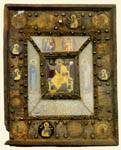|
|
| Byzantine Minor Arts |
12th c., last quarter St Paul Monastery 35 x 27.5 x 2.8 cm |
|

|
The nucleus of this portable wooden icon is an exquisite gilded glass image of Christ Enthroned, executed in the verre eglomisι technique; in the same technique are the five remaining, of the original fourteen, octagonal medallions, with busts of Sts Philip, Thaddeus, Symeon and Thomas. The figures that, with the central figure of Christ, constitute the Deesis, that is, the Virgin and St John and two busts of archangels, are painted on parchment and displayed under glass against a ground of tiny pearls. Gemmed bands of filigree work, typically Venetian in style, separate the three zones. The outer frame and the back of the icon are covered with a thin sheet of gilded metal. Although badly damaged, it seems to have been decorated with a stamped geometrical motif of squares with X's and dots. Venetian objets de luxe like this one, often the product of the joint skills of the glass-worker, the miniaturist and the silversmith, were designed for the large market which, in the years following the Crusader conquest of Constantinople in 1204, grew up wherever the merchants of the Serenissima pursued their activities. In the late thirteenth and early fourteenth centuries especially, control of international trade was in the hands of the Venetian merchants; and this is reflected in the widespread distribution of Venetian luxury goods, found from Portugal to Tabriz and from the Kingdom of Hungary to the monasteries of Mount Athos (Laiou 1982. Cf. Fillitz - Morello, nos. 73, 81-5). This small icon is related to a group of four objects, three of which are found on Mount Athos: a diptych and a cross in the Monastery of St Paul and a diptych in the Monastery of Chelandari. The fourth, the diptych belonging to Andres IV of Hungary, today in the Historical Museum in Berne, is known to date from 1290-26 (Huber 1975, pp. 117ff.). All these treasures share the same filigree decoration and the same exquisite miniatures which, with their Byzantine-Venetian air and their luminous colours, brilliant against a gold ground, are reminiscent of Byzantine enamels. The nearest comparison, however, is with the miniatures illuminating Venetian manuscripts, which were produced in the same workshops (Neff 1993, pp. 7-10). A typically Venetian mannerism is the white line at the edge of the garments, imitating the same detail in the mosaics in San Marco (Demus 1984, pp. 182, 214-5). What distinguishes this icon from the other Venetian works to which we have compared it is its use of gilded glass. The figures, worked in gold and silver sheet, the details incised with a very fine tool, stand out against a ground of deep purple or blue (Gordon 1981, pp. 148-9). Glass-gilding was a technique known to the ancient, Byzantine and Islamic worlds; it made its appearance in Italy in the mid-thirteenth century, a development to which the glass-blowers of Venice seem to have contributed (Swarzenski 1940, pp. 55, 63). This icon is one of the oldest examples of the type, and is not unlike the medallions that once ornamented the tomb of Pope Clement IV (1268), especially in such features as the haloes with petals; this is probably a Gothic detail, and one which is reproduced in the miniatures of this icon (Bertelli 1970, pp. 75-8). The iconography of the enthroned Christ holding the orb of the universe is probably derived from a Northern European model, and may be compared to part of a scene interpreted as Majestas Domini in a Gothic church in Cologne (Schiller 1971, p. 20, fig. 31). We do not know just when this icon, the diptych and the cross came into the monastery's possession; but it appears probable that, like the related diptych in the Chelandari Monastery, they were gifts from the Serb monarch Milutin (1282-1321), who lavished gifts on the Chelandari (Bogdanovic - Djuric - Medakovic 1978, p. 96). Unfortunately, we know very little about the Monastery of St Paul in the late thirteenth century; as for the early fourteenth century, all we know is that it was plundered by the Catalans. The oldest reference to a Serb brotherhood in the Monastery of St Paul dates from 1365, when the Monastery of Xeropotamou sold the desolated monastery to a group of Serb monks (Binon 1942, pp. 183-4. Christou 1987, pp. 153-4).
| |
|
Bibliography: Binon 1942. Huber 1969, pl. 158. Bertelli 1970, p. 76 n. 15, fig. 16. Huber 1975, pp. 141-2. Thesauroi 1979.
| ||
| A. B. | ||
| Index of exhibits of Monastery of St. Paul's 13th century |
||
Reference address : https://www.elpenor.org/athos/en/e218ci31.asp